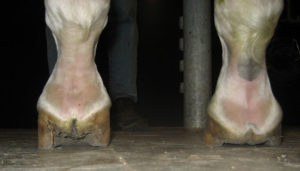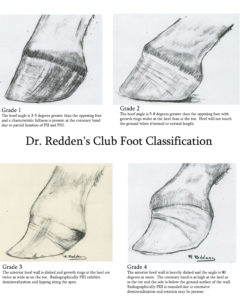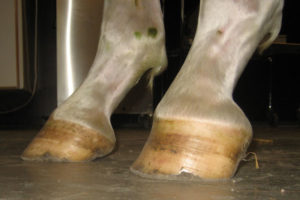Arguably, the most important parts of a horse’s anatomy are the hooves. The hooves are literally the foundation on which the horse is built. Unfortunately, hoof structure is complicated, and there is an entire spectrum of hoof irregularities you may come across. One abnormality that can range from mild to severe is club foot.
Club foot is characterized by a very steep angle of the hoof wall. The heel is very high and will not touch the ground. There is a dish shape at the toe, and a bulging at the coronet band.

The horse appears to be standing on its “tippy toes.” That’s because, it basically is. Club foot is a flexural deformity of the coffin joint, in which the back of the coffin joint is pulled upward. Horses can be born with club foot, which can appear in either front or hind hooves, in a single hoof or in pairs. Or, horses can develop club foot. This most often occurs when a horse is two to six months old, due to rapid growth, nutrition imbalances, overexertion, or genetic predisposition.
Club foot can range from mild to severe. Farriers use a grade scale, based on the angle of the hoof wall. Depending on the severity, horses can maintain some level of soundness with proper shoeing and care. In more extreme cases, weight bearing is painful and the horse will always be lame.

A horse with club foot will have that hoof for life. It is not something that can be fixed. Do not try and force the hoof to take a different shape with trimming and shoeing. Instead, work closely with a knowledgeable farrier and trim the hooves to manage and maintain the horse’s comfort. The horse will most likely need to be shod more often than the average 6-8 weeks, and may have an uneven gait without being lame.
For more information on providing your horse with balanced nutrition, visit Dr. Bray’s Corner on our Integrity Horse Feed website.

